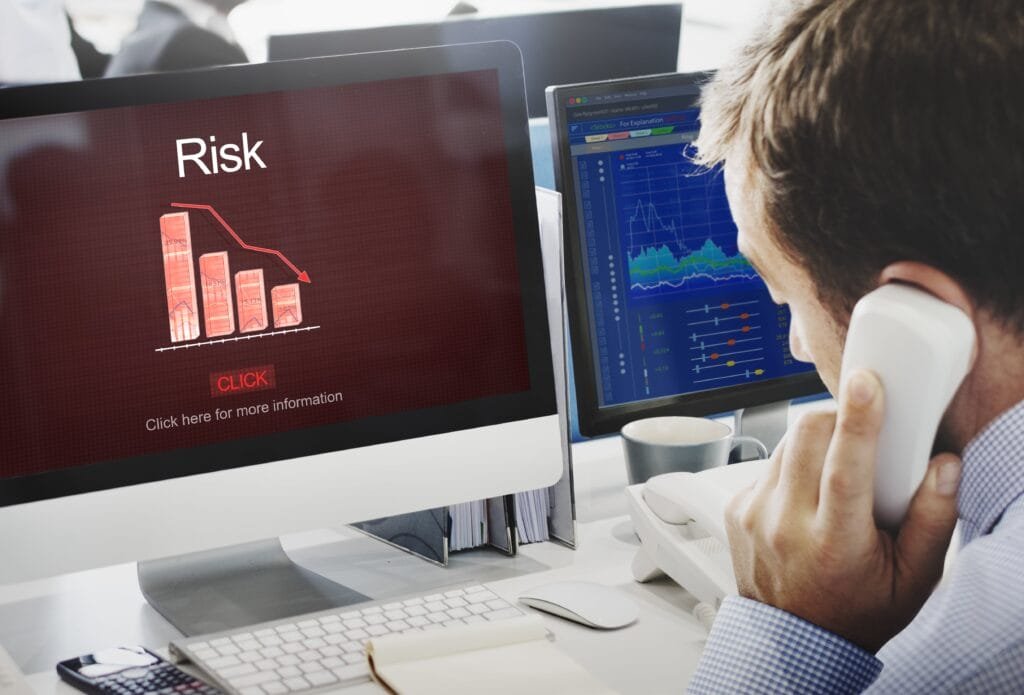The Invisible Threat- How Fourth Party Risk Can Blindside Your Business?
In today’s world, businesses are all connected, kind of like friends helping each other out. It’s pretty normal, just like grabbing a coffee during a break. But, there’s a sneaky danger hiding around that might surprise you – it’s called fourth-party risk. Imagine it like a sneaky chain reaction; your company needs other companies (third parties) for important stuff, but what about the companies those third parties rely on? These are your fourth parties. They’re usually out of sight and not watched closely, but they can shake things up for your business.
The tricky part about fourth-party risk is that it’s hard to see coming. Just when you think you’ve got everything under control, watching every third party like a hawk, those fourth parties sneak up on you with unexpected problems. It’s like that arcade game where you hit the moles with a mallet – as soon as you deal with one issue, another pops up out of nowhere. This sneaky problem means you’ve got to stay alert and ready to act, so your business doesn’t get hit by surprises you didn’t even see coming.
What is a Fourth Party?
Let’s make it simpler to get what we mean by a fourth party. Imagine your business in a big network, like a spider’s web, where all sorts of things like services, information, and products move easily from one spot to another. In this web, the companies you directly deal with, the ones you’ve sort of “shaken hands” with, are your third parties. They’re the ones you’ve checked out and trust.
But here’s the twist: each of those third parties you trust has its circle of friends and helpers. These groups or companies, that work with your third parties but not with you directly, are what we call your fourth parties. They might be the ones providing goods, doing extra work, or offering services that your third parties need to do their job for you. You might not even know they exist, but these fourth parties can affect how your business runs, even though they’re not directly connected to you. This kind of hidden link is what makes fourth-party risk both super interesting for you and a bit tricky to keep an eye on.
Why is Fourth-Party Risk Important?
Going deeper into why we need to watch out for fourth-party risk, it’s all about how it’s hidden from your direct control but can still majorly impact your business. Think of it as a risk that sneaks in unnoticed, skipping past the usual security checks you have for the companies you work with directly.
The big deal with keeping an eye on fourth-party risk is that everything in business today is so connected. If something goes wrong with one of these hidden fourth parties, like a security issue or not following the rules, it can cause trouble for you too. It’s like a domino effect that can mess up how you operate and hurt your good name, sometimes before you even know there’s an issue. In times when a data leak or other problem can cost a lot of money and make customers lose trust, getting a handle on fourth-party risk is super important, not just a good idea.
Also, in businesses where there are strict rules to follow, not being able to handle fourth-party risk well can cause big problems. You might end up breaking the rules, which can lead to big fines and legal troubles. So, it’s really important to pay attention to and deal with fourth-party risk. This helps protect your business from hidden dangers and makes sure everything runs smoothly and securely.
How Fourth-Party Vendors Pose a Threat to Your Business?
Digging deeper into this risk situation, it’s easy to see why companies you don’t directly deal with, called fourth-party vendors, can be a big risk for your business. The main problem is that you don’t have direct control or oversight over these companies. Since they’re outside your immediate circle, it’s much harder to spot problems, make sure they’re following the rules, and handle risks.
One of the biggest risks is cybersecurity. If one of these fourth-party vendors gets hit by a cyberattack or data leak, important information from your network, which you shared with your third parties, could get out. This isn’t just something to imagine; it’s happened for real with big companies, showing how these risks can ripple out and affect many others.
Another big worry is when things don’t go as planned. Imagine if a company you rely on indirectly, like a fourth-party vendor, runs into big trouble, maybe they’re having money problems, there’s a natural disaster, or some big political issue. This can cause a chain reaction leading to delays, extra costs, or even stopping your business activities completely, especially if you depend heavily on this vendor for something important.
Then, there’s the worry about following the rules and legal stuff. If a fourth party doesn’t stick to the laws, regulations, or standards they should like how they treat workers, look after the environment, or handle data, your business could end up in hot water, facing fines, legal trouble, and a hit to your reputation. So, the influence of these fourth-party vendors is huge, shaking up the core of your business, which makes keeping an eye on them a key part of managing risks.
What Do You Need to Know About Your Fourth-Party Vendors?
Dealing with fourth-party risk means you’ve got to get into the nitty-gritty about the companies your business relies on indirectly. Knowing what is super important here, it’s like your shield against trouble. You need to get your hands on some key information to tackle these risks well.
First off, you need to get how your third parties and their fourth parties are connected. What do these fourth parties do? How important are they to the stuff you’re getting from your third parties? Understanding this will help you figure out how big of a deal it would be for your business if one of these fourth parties had a problem.
Next up, you’ve got to check out how tight the security is with your fourth-party vendors and if they’re playing by the rules. What kind of steps are they taking to keep things secure online? How do they look after private information? And do they follow the same big rules and standards that you have to? Knowing this stuff is key to making sure that everything from your data to the services you use stays safe and on the up-and-up.
Then, it’s super important to know how ready these fourth-party vendors are for any bumps in the road, like tech glitches, natural disasters, or other big problems. Have they got a solid plan to keep things running smoothly, no matter what happens? This is all about making sure they can keep delivering what you need, even when things get tough.
Finally, it’s super important to have clear communication and openness between your third parties and their fourth parties. How do they let you know if there’s a risk popping up? In what ways do they have to keep an eye on things and tell you about any problems with fourth parties?
With all this information in hand, you can start to build a really good plan for handling risks that cover not just the companies you deal with directly but also those hidden parts of your business world.
Should Vendor Assessments Include Fourth Parties?

Checking on your fourth-party vendors isn’t just a smart move, it’s pretty much a must in today’s closely connected business world. As we’ve dug into how third and fourth parties are linked, it’s clear that these behind-the-scenes players can affect your business just as much as the ones you deal with directly. So, making sure you also check out these fourth parties is key for a solid plan to handle risks.
Looking into fourth-party vendors is helpful in a few big ways. First off, it lets you see more of the risk picture, finding possible weak spots that you might not notice until something goes wrong. This wider view helps you get ahead of problems, dealing with them before they get bigger.
Second, it helps you stick to the rules better. A lot of rules nowadays understand that vendor risk can trickle down and expect businesses to make sure everyone they work with, including further down the chain, is following the rules too. By checking on your fourth parties, you’re doing more than just meeting a requirement; you’re protecting your business from the kind of trouble with the law or bad press that can come from not following these rules.
Also, looking into your fourth-party vendors encourages everyone to be more open and work together better in your supply chain. It makes your third parties more willing to share about who they work with, which helps everyone communicate better and line up their approaches to handling risks.
In short, checking on your fourth-party vendors is a way to make your business stronger, more secure, and more rule-following. It’s like the saying “Knowing what’s coming helps you prepare.” This helps your business be ready and smart about dealing with the complicated connections you have with all the different companies you work with.
How to Manage and Assess Fourth-Party Risks?
Managing and checking on risks from your fourth-party vendors is tricky and needs a careful plan. It means you have to look beyond the companies you work with directly to make sure the ones they depend on don’t become a weak spot for you. Here’s a way to tackle it:
- Make a Detailed Plan for Handling Risks: You need a plan that covers rules, steps, and tools for spotting, checking, and dealing with risks from everyone you work with, including the companies your vendors depend on. This plan should be a part of your bigger strategy for managing risks, making sure you handle risks the same way at every level.
- Work Together with Your Vendors: Get to know the companies that your vendors use by talking closely with your direct vendors. Push for openness and make sure they’re checking how risky their vendors are. Working together like this can help you see and manage risks better, even those that are a few steps removed from you.
- Keep an Eye on Things All the Time: Checking risks isn’t just a one-off thing; you need to keep an eye on it continuously. Use tools and tech that let you see what’s happening with the risk levels of your vendors (and their vendors) in real time. This could include using special software for spotting online threats, checking that rules are being followed, and keeping an eye on your entire supply chain.
- Do Regular Checks and Reviews: Every so often, you should check that your vendors’ vendors are sticking to your security and risk rules. This might mean sending them questionnaires, doing audits, or looking for official stamps of approval. You want to make sure they’re keeping up with the needed security, rule-following, and ability to bounce back from problems.
- Plan for What-Ifs: Be ready for any issues that might come up with your vendors’ vendors. Have backup plans ready, like a list of other vendors you can use, strategies for dealing with problems quickly, and plans for how to tell everyone involved what’s going on. This helps keep your business running smoothly even when there are bumps in the road.
- Spread the Word About Risk Security: Teach everyone involved in your business why managing risks from your vendors (and theirs) is important. This means training your team, talking to your direct vendors, and making sure the companies they rely on know what you expect when it comes to managing risks.
By following these steps, you’ll make your business stronger and more prepared to handle the tricky challenges that come with risks from your vendors’ vendors. This forward-thinking way of doing things not only keeps your business secure but also shows that you’re serious about keeping things secure, following the rules, and doing a great job, especially as businesses become more and more connected.
The Connection Between Third-Party Risk Management and Fourth-Parties
When we dive into managing risks from other companies we work with, we soon find out how important it is to also look at the companies they rely on, which we call fourth parties. This shows us how risks can ripple through the whole supply chain. Even the actions of companies that are a few steps removed can end up affecting your business.
At the center of this issue is something called “risk transference.” This means when you work with other companies, you’re not just dealing with their risks, but also the risks from the companies they depend on, including fourth parties. Because of this, managing risks with your direct vendors isn’t enough; you need to think about the entire network that supports them.
The synergy between third-party risk management and fourth-party oversight involves several key components:
- Checking Carefully: Just like you carefully check the companies you work with directly, they should do the same with their vendors. This way, everyone is keeping an eye out for possible risks before they turn into bigger problems.
- Making Rules in Contracts: When you make deals with your direct vendors, you should include rules that make them take care of their vendor risks. This might mean they have to meet certain security standards, follow specific rules, and let you check on their work with other companies.
- Working Together: Managing risks is something everyone involved should be part of, By being open and working closely with the companies you work with, you can lower the risks that come from further down the supply chain, including those from fourth parties.
- Including Everyone in Risk Checks: When you’re looking at risks to your business, make sure to think about the risks from fourth parties too. This way, you won’t miss any hidden problems that could mess up your plans. Seeing the whole picture of risks helps you protect your business better.
- Staying in Touch and Watching Closely: You need to keep an ongoing conversation and watch over the security levels of both the companies you work with and their vendors. Setting up regular times to catch up and using technology to keep an eye on risks as they happen can make handling these risks smoother.
By mixing how you manage risks from the companies you work with directly and keeping an eye on their vendors too, you build a strong defense that keeps your business secure from the domino effect of problems in the supply chain. This link doesn’t just make your business tougher; it also makes sure you’re covering all your bases in protecting your operations, making sure you’re not missing anything important.
Common Types of Fourth-Party Risks

Common Types
Getting to grips with the risks from fourth-party companies means knowing the different kinds of problems they might bring into how your business runs. These risks can be all sorts of things and affect you in different ways, but there are a few usual suspects that businesses should watch out for:
- Cybersecurity Risks: In today’s online world, one big worry is cybersecurity. Risks from fourth parties might include weak spots in their systems that attackers could use to get at your data or mess with your systems. This could happen if they’re not super careful about security, like using simple passwords, not updating their software, or not keeping data secure enough.
- Operational Risks: This is about the chance that the companies you rely on indirectly might run into trouble delivering what you need. This could be because of money problems, issues with getting supplies, natural disasters, or big political changes. If they have problems, it could end up causing problems for you too, making it hard to take care of your customers.
- Compliance Risks: If these fourth parties don’t follow the rules and laws that apply, it could spell trouble, especially if their rule-breaking affects your business. This could be anything from not protecting data properly to unfair work practices or harming the environment. If they’re not playing by the rules, it could lead to legal problems or make people think less of your business.
- Reputational Risks: What your fourth parties do can bounce back on your business’s image. If they’re caught doing something shady, treating workers badly, or not caring about the environment, it could make people upset with your company, not just theirs.
- Financial Risks: If the companies your business relies on are having money troubles or might go under, it could mess up their ability to give you what you need. This could end up costing your business money.
- Strategic Risks: If a company you depend on decides to change how they do things, who owns them, or who runs them, it could mean they might not serve you as well, change their prices, or stop providing something you need. This could throw off your business plans and affect how you stand in the market.
- Legal Risks: If one of these companies gets tangled up in legal problems or the government starts looking into them, it could spell trouble for you too, especially if you rely heavily on what they provide for your business to run smoothly.
By watching out for these usual risk types, businesses can come up with better plans to keep an eye on and lessen the possible problems that can come from working with third-party companies. This helps make the whole supply chain stronger and more secure.
Creating Your Fourth-Party Risk Management Plan
Making a strong plan to manage risks from fourth-party companies is like putting a lighthouse on the coast of your business. It helps you navigate through the foggy and uncertain parts of dealing with your supply chain. This plan should be detailed and ready to go, showing how you’ll spot, check, keep an eye on, and lower the risks from these fourth-party companies. Here’s a guide on how to create your plan:
- Find Out Who Your Fourth Parties Are: First, figure out who you’re working with by looking closely at your supply chain. You need to know your third parties (the companies you deal with directly) and then find out who their important suppliers and service providers are (your fourth parties). You might need to work with your third parties to see who they’re using.
- Check How Much Risk They Bring: Look at how each fourth party might affect your business, thinking about the different kinds of risks. Decide which ones are the most important based on how critical they are to your business and how big of a risk they pose.
- Make Rules for Handling Risks: Set up clear rules and standards for dealing with risks from fourth parties. These rules should fit with your overall plan for managing risks and cover things like security, following laws, keeping things running smoothly, and being ethical.
- Do Your Homework: For the fourth parties that matter the most, take a close look to see how risky they are. This means checking their security, whether they meet certain standards, how financially sound they are, and their plans for if things go wrong.
- Set Up Ways to Keep an Eye on Them: Create a system for watching over the risks from fourth parties all the time. This could include checking in on them regularly, reviewing how they’re doing, and using tools that let you monitor them in real time. Make sure you have a way to let the right people in your company know if there’s a problem.
By carefully making and using your plan to manage risks from fourth-party companies, you can spot potential problems before they get bigger. This helps your business move smoothly through the complicated world of working with an extended network of suppliers and service providers.
In conclusion
Dealing with the hidden dangers of fourth-party risks is super important in today’s world, where problems in the supply chain can spread far and affect a lot. By really understanding these risks, knowing why they matter, and putting a good plan in place to manage them, businesses can protect themselves from unexpected problems, security issues, and breaking rules. It might seem like a big challenge to figure out, check, and handle these fourth-party risks, but it’s worth doing. With the right knowledge, staying alert, and being ready to act, your business can not only survive these hidden threats but also come out stronger, more prepared, and ahead of the game in the complex world of business today.
FAQs
What exactly is fourth-party risk?
Fourth-party risk refers to the potential vulnerabilities and threats that your business is exposed to indirectly through your third-party vendors’ network of suppliers, service providers, and partners.
How does fourth-party risk differ from third-party risk?
While third-party risk arises directly from the companies you do business with, fourth-party risk stems from the entities that your third parties depend on. The main difference lies in the directness of the relationship and the level of control and visibility you have over these entities.
Why is it challenging to manage fourth-party risks?
Fourth-party risks are challenging to manage due to the lack of direct visibility and control over these entities. Often, businesses do not have direct contractual relationships with third parties, making it difficult to enforce compliance and risk management practices.
Can a fourth-party risk cause a data breach in my company?
Yes, a fourth-party risk can lead to a data breach if the fourth party has access to your data through a third party and suffers a security compromise. The interconnected nature of vendor relationships means vulnerabilities can cascade up the supply chain.
How can I identify my fourth-party vendors?
Identifying fourth-party vendors typically involves working closely with your third-party vendors to map out their supply chains and understand which entities they depend on for delivering services or products to your business.







